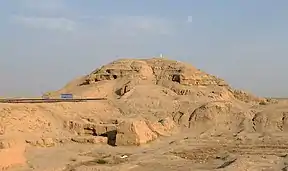Shu-Sin
Shu-Sin, also Šu-Suen (Akkadian: 𒀭𒋗𒀭𒂗𒍪: DŠuDSîn, after the Moon God Sîn", the "𒀭" being a silent honorific for "Divine", formerly read Gimil-Sin) was king of Sumer and Akkad, and was the penultimate king of the Ur III dynasty. He succeeded his father Amar-Sin,[1] and reigned c. 1973–1964 BC (short chronology).
| Shu-Sin 𒀭𒋗𒀭𒂗𒍪 | |
|---|---|
 | |
| King of the Neo-Sumerian Empire | |
| Reign | c. 2037 BC – 2028 BC
(Middle Chronology) c. 1973 BC – 1964 BC (Short Chronology) |
| Predecessor | Amar-Sin |
| Successor | Ibbi-Sin |
| Issue | Ibbi-Sin |
| Dynasty | 3rd Dynasty of Ur |
| Father | Shulgi |
Reign
Following an open revolt of his Amorite subjects, he directed the construction of a fortified wall between the Euphrates and the Tigris rivers in his fourth year, intending it to hold off any further Amorite attacks. He was succeeded by his son Ibbi-Sin.
An erotic poem addressed to Shu-Sin by a female speaker is preserved in a cuneiform tablet.[2] The poem's speaker expresses her strong desires and longings for the king.[3][4][5]
An inscription states that he have his daughter in marriage to the ruler of Simanum ""His daughter was given as a bride to Simanum. Simanum, Habura, and the surrounding districts rebelled against the king, they chased his daughter away from her residence." Shu-Sin subsequently conquered Simanum and restored his daughter there.[6]
Year names of Shu-sin
The year names for the reign of Shu-sin are all known and give an information about the events of his reign. The most important ones are:[7]
1 Year Szu-Sin became king
2 Year Szu-Sin the king of Ur made / caulked the boat of Enki (called the) 'ibex of the abzu'
3 Year Szu-Sin the king of Ur destroyed Simanum
4 Year Szu-Sin the king of Ur built the amurru wall (called) 'muriq-tidnim / holding back the Tidanum'
6 Year Szu-Sin the king of Ur erected a magnificent stele for Enlil and Ninlil
7 Year Szu-Sin, the king of Ur, king of the four quarters, destroyed the land of Zabszali
9 Year Szu-Sin the king of Ur built the temple of Szara in Umma
Artifacts
There is vast number of artifacts with inscriptions in the name of Shu-sin.[8]
 Door socket inscribed with the name of Shu-Sin, king of Ur, Ur III. From Mesopotamia, Erbil Civilization Museum.
Door socket inscribed with the name of Shu-Sin, king of Ur, Ur III. From Mesopotamia, Erbil Civilization Museum..jpg.webp) Inscription with the name of Shu-Sin
Inscription with the name of Shu-Sin.jpg.webp) Seal of Shu-Sin: "Shu-sin, the Great King, King of Ur, King of the four world quarters..."
Seal of Shu-Sin: "Shu-sin, the Great King, King of Ur, King of the four world quarters..." Inscribed stone ring of a fountain, in the name of king Shu-Sin. Pergamon Museum.
Inscribed stone ring of a fountain, in the name of king Shu-Sin. Pergamon Museum. Inscription of King Shu-Sîn, commemorating the construction of the temple of the god Shara at Umma. Musée national d'histoire et d'art, Luxembourg, Cabinet des Médailles.
Inscription of King Shu-Sîn, commemorating the construction of the temple of the god Shara at Umma. Musée national d'histoire et d'art, Luxembourg, Cabinet des Médailles..jpg.webp)
See also
References
- "Sumerian King List", Wikipedia, 2022-11-29, retrieved 2022-12-05
- "Oldest love poem". Guinness World Records. Retrieved 2019-07-18.
- Fant, Clyde E.; Reddish, Mitchell G. (2008-10-15). Lost Treasures of the Bible: Understanding the Bible Through Archaeological Artifacts in World Museums. Wm. B. Eerdmans Publishing. ISBN 9780802828811.
- Longman, Tremper III; Enns, Peter (2008-06-06). Dictionary of the Old Testament: Wisdom, Poetry & Writings: A Compendium of Contemporary Biblical Scholarship. InterVarsity Press.
- "The World's Oldest Love Poem". World History Encyclopedia. Retrieved 2019-07-18.
- Michalowski, Peter, "The Bride of Simanum", Journal of the American Oriental Society, vol. 95, no. 4, pp. 716–19, 1975
- "T6K4.htm". cdli.ucla.edu.
- "CDLI-Found Texts". cdli.ucla.edu.
- Klecel, Weronika; Martyniuk, Elżbieta (July 2021). "From the Eurasian Steppes to the Roman Circuses: A Review of Early Development of Horse Breeding and Management". Animals. 11 (7): 1859. doi:10.3390/ani11071859. ISSN 2076-2615. PMC 8300240. PMID 34206575.
- Aruz, Joan; Farkas, Ann; Fino, Elisabetta Valtz; N.Y.), Metropolitan Museum of Art (New York (2006). The Golden Deer of Eurasia: Perspectives on the Steppe Nomads of the Ancient World. Metropolitan Museum of Art. p. 4. ISBN 978-1-58839-205-3.
- Nicole Brisch, The Priestess and the King: The Divine Kingship of Šū-Sîn of Ur, Journal of the American Oriental Society, vol. 126, no. 2, pp. 161–176, (Apr. - Jun., 2006)
- Stiebing Jr., William H. (2003). Ancient Near Eastern History and Culture. New York: Pearson Education. ISBN 0-321-06674-X.
